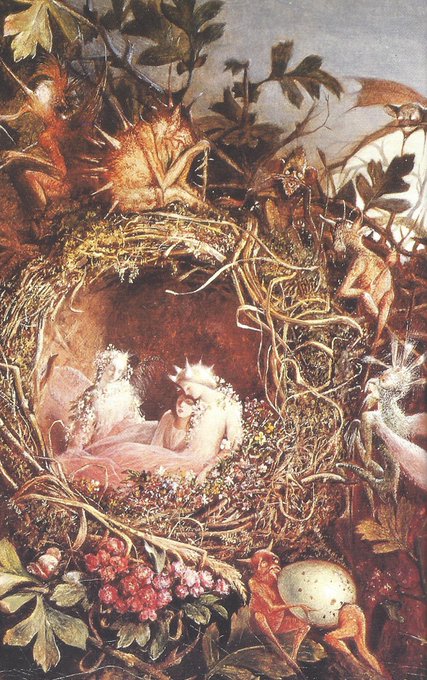folkloreSundayのTwitterイラスト検索結果。 243 件中 7ページ目
In #JapaneseFolklore there is a #yokai known as akateko that takes the form of a red, disembodied child's hand. It drops from the branches of Japanese honey locust trees to 'surprise' those below. Aside from the extreme creepiness of this yokai, it is believed...
#FolkloreSunday
Huldra is a seductive nymph in Norwegian folklore. In early lore she is often described as having a hollow back, but later (C19th onwards) depictions focus on her beauty. She is known for her long blonde hair, and a tail that falls off if she marries a man.
#FolkloreSunday
In olden times the ‘whispering’ leaves of the Aspen #tree were believed to be imbibed with communicative powers. It was said that an aspen leaf placed beneath the tongue bestowed upon a person the gift of eloquence, or even the ability to speak multiple languages. #FolkloreSunday
The Malaysian penanggalan looks like a woman by day, but at night detaches its head from its body & flies around with its spinal column & internal organs dangling while it hunts for prey. It uses its long tongue as a straw to drain humans to death. #FolkloreSunday
The nasnas is the monstrous offspring of a human & a demon in Arab folklore. It's described as half a human: half a head, half a body, one arm, one leg, & sometimes a bat-like wing. But they're agile at hopping, & can beat a human to death with their one hand. #FolkloreSunday
Hi everyone, hope you are having a great week so far! A reminder that this Sunday’s theme is:
THE BODY
Get those tweets on HEADS, SHOULDERS, KNEES & TOES (and more!) ready for retweeting on the hashtag #FolkloreSunday after 10:30 am BST
Thank you all for your wonderful tweets on thresholds & transitions. This is @frome_maude heading off into the new moon energy.
Next week’s theme is:
The BODY - so get those tweets on HEADS, SHOULDERS, KNEES & TOES ready for retweeting after 10:30 am BST #FolkloreSunday xx
#FolkloreSunday
In Greek myth the Horae are sisters who personify Spring, Summer & Autumn. As the days shorten, and green leaves turn to red and yellow. It is our cue that the dance of the Horae sees Summer prepare to hand the mantle of the changing seasons to her sister Autumn.
Changing Woman, the revered Navajo goddess, represents the earth's changing seasons, the life cycle, & the transitions in a girl/woman's life, such as menarche, weddings, & childbirth. She becomes an old woman every winter & a young woman again by spring. #FolkloreSunday
Contrary to their frequent portrayal in modern fantasy, the house fairies of British folklore were not slaves. They would cook and clean for a human family because they wanted to. If the family was disrespectful, the fairy would punish them for the offense.
#FolkloreSunday
According to Eastern Slavic mythology, if millers appease Vodyanoy, the water spirit, it'll help them by bringing water to their mills during dry spells. If they offend Vodyanov, millers can cast bread and vodka into the stream to make amends 🐟
#swampsunday #FolkloreSunday
🎨Alt
Shellycoat is a type of Brownie from Anglo-Scottish Borders folklore, that inhabits rivers and other water bodies. It's name, from the coat of shells it wears. It's relatively harmless unless humans trespass on it's territory
#swampsunday #folkloresunday
art: unknown
"When the wind makes the straws and leaves whirl as it passes, that is the fairies, and the peasantry take off their hats and say, 'God bless them'”.
~Fairy & Folk Tales of the Irish Peasantry (1888)
#FolkloreSunday
In West African myth, the Aziza are a supernatural race that lives in anthills & silk cotton trees. They taught humans how to use fire, & use magic to aid hunters. Originally described as little hairy folk, they're now commonly portrayed as resembling fairies. #FolkloreSunday
Hi everyone, hope you are all having a great week so far! A reminder that this Sunday’s theme is:
FAIRIES, GOBLINS, ELVES, BOGGARTS & OTHER CREATURES
of the OTHERWORLD.
Retweets after 10:30 am BST #FolkloreSunday Maude xx
Moths are Viewed as a Symbol of Death or as messengers for the Dead. They are sometimes thought of as witches or A need to clean your soul. Either way this sibling of the butterfly has some interesting legends that you should explore. #FolkloreSunday #AI
https://t.co/2utzDqFnrg
#FolkloreSunday @FolkloreSunday; In multiple Native American mythologies, Deer Woman appears as a beautiful woman with deer feet or just a deer. She's normally associated with fertility and love, however she is known to take vengeance on men who hurt women and children.
"I used to meet her in the garden, the ravine, and in the manor fields. She was always picking flowers and herbs, those she knew her father could use for healing drinks and potions."
- Hans Christian Andersen's,
The Wind's Tale
🎨 Illustrated by Edmund Dulac
#FolkloreSunday
🌿🪶🌿Celandine was sometimes known as Swallow-wort, from the belief that swallows would feed the plant to their young to cure weak eyesight.
#FolkloreSunday













































